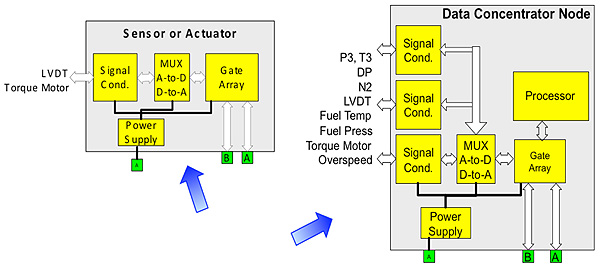Objectives
Distributed Engine Control (DEC) Technology helps achieve these objectives by creating and advancing the control system hardware technology to overcome engine system constraints which prevent the acceptance or optimization of many new engine technologies.
DEC Objectives:
- Create a sustainable high temperature electronics infrastructure which will allow growth and integration of new control system technologies thus enabling a pathway to new engine technologies consistent with VAATE goals.
- Create new tools which advance and help validate soft and hard control technologies which improve vehicle performance metrics and reduce specific energy consumption.
Objective: Modular, Open, Distributed Engine Control
Technology Benefits
- Increased Performance
- Reduction in engine weight due to digital signaling, lower wire/connector count, reduced cooling need
- 5% increase in thrust-to-weight ratio
- Improved Mission Success
- System availability improvement due to automated fault isolation, reduced maintenance time, modular LRU
- 10% increase in system availability
- Lower Life Cycle Cost
- Reduced cycle time for design, manufacture, V&V
- Reduced component and maintenance costs via cross-platform commonality, obsolescence mitigation
- Flexible upgrade path through open interface standards
Technology Maturity
- High Temperature Electronics
- Commercially available SOI integrated circuits
- Demonstrated durability of SiC components to 500 C
- Multilevel SiC interconnect structures targeted FY08
- Communications
- Commercially available communication technologies for mission critical control applications
- Distributed Systems Architecture
- Demonstrated technology used in industrial control applications
- Widely available commercial hardware and software components and integration tools for industrial applications
Capability Needs
- Open Systems Development, Modeling & Design
- Future systems requirements definition
- Open industry interface standards definition
- System modeling tools development
- Modular system integration and test techniques
- Hardware Systems Development
- High temperature integrated circuits and systems development
- Improved electronic component availability
- Software Systems Development
- Software system partitioning
- Software design and modular test capability
- Software distributed system V&V
Capability Risk
- Government Leadership
- Failure to adequately fund consistent programs to encourage unified development activity
- Failure to provide direction for government goals and objectives resulting in lack of future capability
- Industry Cooperation
- Failure to create and maintain industry buy-in to open systems approach leading to less innovative, less reliable and more proprietary/protectionist systems at high cost to end user.
- Inclusive Innovation
- Failure to provide opportunities for small business and academic innovation
DECWG Objective - Leverage a Common Set of Parts

- Same set of SOl parts scaled from smart sensors to single loop module to complete core data concentrator
- Leverage commonality & quantity to drive down cost
Common Set of High Temp Parts Allows Scalable Hi-T Controls